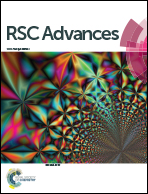Development of a colorimetric and NIR fluorescent dual probe for carbon monoxide†
Abstract
Carbon monoxide (CO) has captivated great attention in part due to the discovery of the therapeutic and cell-signalling role that CO plays in biological systems. The ever-increasing interest in CO has resulted in the development of rapid and facile approaches for the sensitive and selective detection of CO, which still remains challenging. Herein, the first example of a colorimetric and near-infrared fluorescent dual probe for carbon monoxide (CO) has been developed by assembling an allyl chloroformate moiety with a naphthofluorescein fluorophore, which enables the label-free and visual detection of CO. The living cell imaging results indicate that the probe shows great potential in sensing intracellular CO.


 Please wait while we load your content...
Please wait while we load your content...